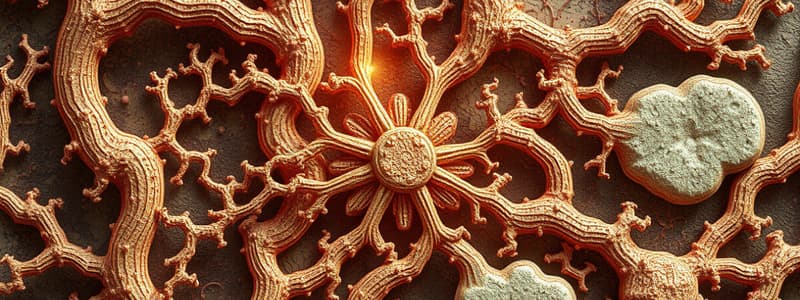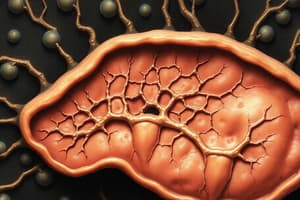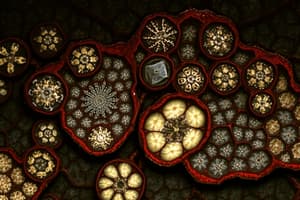Podcast
Questions and Answers
What is the primary role of glycosaminoglycans (GAGs) in the ground substance?
What is the primary role of glycosaminoglycans (GAGs) in the ground substance?
- To act as a source of energy for cell metabolism
- To promote cell division within connective tissues
- To attract and absorb water, affecting viscosity (correct)
- To provide structural rigidity to tissues
When a glycosaminoglycan (GAG) is attached to a protein, what larger molecule does it form?
When a glycosaminoglycan (GAG) is attached to a protein, what larger molecule does it form?
- Proteoglycan (correct)
- Collagen
- Fibronectin
- Elastin
What characteristic of glycosaminoglycans enables the movement of water within the ground substance?
What characteristic of glycosaminoglycans enables the movement of water within the ground substance?
- Their negative charge and hydrophilicity (correct)
- Their ability to form covalent bonds
- Their hydrophobic nature
- Their high molecular weight
Which type of ground substance is exemplified by cartilage?
Which type of ground substance is exemplified by cartilage?
Which molecule in the ground substance serves as a bonding agent for connective tissue cells and fibers?
Which molecule in the ground substance serves as a bonding agent for connective tissue cells and fibers?
What is the primary structural role of collagen fibers in connective tissue?
What is the primary structural role of collagen fibers in connective tissue?
Which type of fiber is characterized by its ability to stretch and recoil?
Which type of fiber is characterized by its ability to stretch and recoil?
Where are reticular fibers particularly abundant?
Where are reticular fibers particularly abundant?
Why are collagen fibers sometimes referred to as 'white fibers'?
Why are collagen fibers sometimes referred to as 'white fibers'?
Which statement about wandering cells in connective tissue is accurate?
Which statement about wandering cells in connective tissue is accurate?
Which of the following symptoms is NOT associated with scurvy?
Which of the following symptoms is NOT associated with scurvy?
What was a historical solution for preventing scurvy among sailors?
What was a historical solution for preventing scurvy among sailors?
Which of the following is a common modern treatment for collagen production disorders?
Which of the following is a common modern treatment for collagen production disorders?
Vitamin C is primarily important for the maintenance of which type of tissue?
Vitamin C is primarily important for the maintenance of which type of tissue?
Scurvy primarily arises from a deficiency of which vitamin?
Scurvy primarily arises from a deficiency of which vitamin?
Which of the following foods is NOT mentioned as high in vitamin C?
Which of the following foods is NOT mentioned as high in vitamin C?
What is the primary function of mesenchyme in embryonic development?
What is the primary function of mesenchyme in embryonic development?
Which statement correctly describes the composition of mesenchyme?
Which statement correctly describes the composition of mesenchyme?
What role do mesenchymal cells play in adult connective tissues?
What role do mesenchymal cells play in adult connective tissues?
Which characteristic differentiates mucous connective tissue from mesenchyme?
Which characteristic differentiates mucous connective tissue from mesenchyme?
What shape are the mesenchymal cells found in both mesenchyme and mucous connective tissue?
What shape are the mesenchymal cells found in both mesenchyme and mucous connective tissue?
What type of ground substance is associated with mesenchyme?
What type of ground substance is associated with mesenchyme?
Which of the following is a true statement regarding the formation of connective tissues from mesenchyme?
Which of the following is a true statement regarding the formation of connective tissues from mesenchyme?
Which of the following best describes the role of immature protein fibers in mesenchyme?
Which of the following best describes the role of immature protein fibers in mesenchyme?
What is one primary advantage of using umbilical cord blood (CB) stem cells for transplants?
What is one primary advantage of using umbilical cord blood (CB) stem cells for transplants?
Which statement best describes a limitation of umbilical cord blood (CB) transplants?
Which statement best describes a limitation of umbilical cord blood (CB) transplants?
What is a potential use for umbilical cord blood besides treating leukemia?
What is a potential use for umbilical cord blood besides treating leukemia?
Why might public banking of umbilical cord blood (CB) be considered more beneficial than private banking?
Why might public banking of umbilical cord blood (CB) be considered more beneficial than private banking?
What type of disorders have umbilical cord blood transplants (UCBT) successfully cured?
What type of disorders have umbilical cord blood transplants (UCBT) successfully cured?
Which statement accurately describes the structure of mesenchyme?
Which statement accurately describes the structure of mesenchyme?
What function does mucous connective tissue serve?
What function does mucous connective tissue serve?
Where is mucous connective tissue predominantly located?
Where is mucous connective tissue predominantly located?
How does the presence of immature protein fibers in mucous connective tissue compare to mesenchyme?
How does the presence of immature protein fibers in mucous connective tissue compare to mesenchyme?
What is the primary origin of all other connective tissue types?
What is the primary origin of all other connective tissue types?
What shape are mesenchymal cells typically classified as?
What shape are mesenchymal cells typically classified as?
In terms of ground substance, what is true about mesenchyme?
In terms of ground substance, what is true about mesenchyme?
Which function does mesenchyme specifically NOT provide?
Which function does mesenchyme specifically NOT provide?
What differentiates mucous connective tissue from mesenchyme at a cellular level?
What differentiates mucous connective tissue from mesenchyme at a cellular level?
What is a common characteristic of both mesenchyme and mucous connective tissue?
What is a common characteristic of both mesenchyme and mucous connective tissue?
Which type of connective tissue is specifically found within the umbilical cord?
Which type of connective tissue is specifically found within the umbilical cord?
What is a primary function of the stem cells found in cord blood?
What is a primary function of the stem cells found in cord blood?
Which type of connective tissue property distinguishes supporting connective tissue from connective tissue proper?
Which type of connective tissue property distinguishes supporting connective tissue from connective tissue proper?
Which type of connective tissue includes bone and cartilage?
Which type of connective tissue includes bone and cartilage?
How do the protein fibers in mucous connective tissue compare to those in mesenchyme?
How do the protein fibers in mucous connective tissue compare to those in mesenchyme?
What is the primary characteristic of fluid connective tissue?
What is the primary characteristic of fluid connective tissue?
What best describes the function of connective tissue proper?
What best describes the function of connective tissue proper?
Which differentiating factor is associated with supporting connective tissue over fluid connective tissue?
Which differentiating factor is associated with supporting connective tissue over fluid connective tissue?
What is the significance of harvesting cord blood immediately after birth?
What is the significance of harvesting cord blood immediately after birth?
Which type of connective tissue is NOT considered fluid connective tissue?
Which type of connective tissue is NOT considered fluid connective tissue?
Flashcards are hidden until you start studying
Study Notes
Wandering Cells
- Wandering cells are mobile components of the immune system found in connective tissue.
- They aid in repairing damaged extracellular matrix and are primarily types of leukocytes.
- These cells provide defense against harmful agents in the body.
Protein Fibers
- Collagen fibers: Strong, unbranched, cable-like fibers, known as white fibers; make up 25% of the body's protein; stronger than steel of the same diameter; abundant in tendons and ligaments.
- Reticular fibers: Thinner than collagen, forming a branching framework; composed of the same protein subunits as collagen; found in lymph nodes, spleen, and liver.
- Elastic fibers: Contain elastin, appear wavy, and can stretch and recoil; known as yellow fibers; visible in stained tissue; found in skin, arteries, and lungs.
Ground Substance
- Ground substance is a non-cellular component of connective tissue where cells and protein fibers reside.
- It can be viscous (blood), semisolid (cartilage), or solid (bone), contributing to the extracellular matrix.
- Glycosaminoglycans (GAGs) are polysaccharides that attract water, influencing the viscosity of the ground substance; types include chondroitin sulfate, heparan sulfate, and hyaluronic acid.
- Proteoglycans are larger molecules formed from GAGs and proteins, and glycoproteins act as adhesives within the ground substance.
Scurvy
- Scurvy results from vitamin C deficiency, essential for collagen production.
- Symptoms include weakness, gum ulceration, hemorrhage, and abnormal bone growth.
- Common among 19th-century sailors, who learned to prevent it by consuming citrus fruits.
- Treatment includes vitamin C-rich foods or supplements.
Embryonic Connective Tissue
- Mesenchyme: First connective tissue in the embryo, dispersed within gel-like ground substance; formative tissue for all other connective tissues; supports tissue repair.
- Mucous Connective Tissue: Also known as Wharton's jelly; contains more immature protein fibers than mesenchyme; supports the umbilical cord.
Classification of Connective Tissue
- All connective tissue originates from mesenchyme in the developing fetus.
- Classified into three categories:
- Connective Tissue Proper: Comprising loose and dense connective tissues.
- Supporting Connective Tissue: Includes cartilage (hyaline, elastic, fibrocartilage) and bone (compact, spongy).
- Fluid Connective Tissue: Encompasses blood and lymph.
Connective Tissue Proper
- Comprises loose connective tissue (fewer cells and fibers, more ground substance) and dense connective tissue (more fibers, less ground substance).
Loose Connective Tissue
- Areolar Connective Tissue: Highly vascularized, with an unconfined arrangement of fibers; serves as a packing material in the body and provides support.
- Adipose Connective Tissue: Composed of adipocytes; functions in energy storage and insulation; consists of brown (heat generation) and white (energy storage and cushioning) adipose tissue.
- Reticular Connective Tissue: Contains leukocytes and fibroblasts, forming the stroma of lymphatic organs such as the spleen and lymph nodes.
Dense Connective Tissue
- Composed mainly of protein fibers with less ground substance; includes three categories:
- Dense Regular Connective Tissue: Fibers running parallel, providing tensile strength in one direction.
- Dense Irregular Connective Tissue: Fibers arranged irregularly, providing strength in multiple directions.
- Elastic Connective Tissue: Contains elastic fibers, allowing for stretch and recoil.
Studying That Suits You
Use AI to generate personalized quizzes and flashcards to suit your learning preferences.




